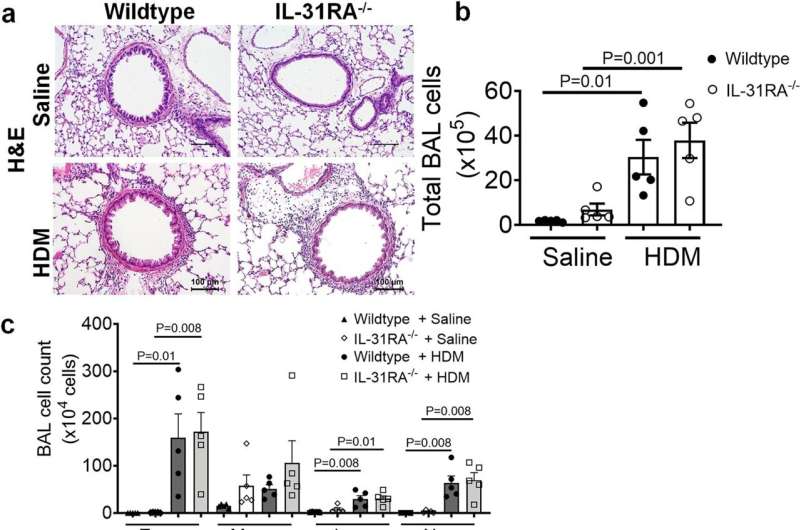This article has been reviewed according to Science X's editorial process and policies. Editors have highlighted the following attributes while ensuring the content's credibility:
fact-checked
peer-reviewed publication
trusted source
proofread
Study identifies molecule that could improve asthma treatments

Researchers are passionate about their fields of study for a variety of reasons. For Satish Madala, his focus on asthma is deeply personal.
"This is my 'close to heart' project because I came to this research area mainly because of my childhood asthma," says Madala, Ph.D., of the Division of Pulmonary, Critical Care, and Sleep Medicine at the University of Cincinnati College of Medicine. "When I would ride my bike on the streets with my friends and I had diesel exhaust exposure, I had an asthma attack. I always wondered why my friends were fine and I was not. 'What's wrong with my lungs?' I wondered."
Asthma is a common chronic airway inflammatory disease that affects more than 300 million people worldwide. Madala headed up a team of researchers at UC and Cincinnati Children's on a study that identified a new molecule that plays a role in asthma and could be targeted for treatment in the future.
The research was published in the journal Nature Communications.
"The study has implications beyond asthma because it is looking at what happens in a smooth muscle cell which is present around our airways, blood vessels and other organs," Madala says. "Every tube structure that we have in our body is built up with the smooth muscles."
Madala says this paper used asthma as a disease model where significantly increased levels of the studied molecule were found in smooth muscle cells of the airways in animal models with allergic asthma.
Further investigation revealed that common asthma-associated cytokines could directly trigger this increase in both human and animal airway smooth muscle cells. These cells play a crucial role in airway constriction or the narrowing of the airways.
Intriguingly, blocking that one specific molecule through genetic manipulation in animals led to a significant reduction in the narrowing of airways without affecting other key asthma features like inflammation and mucus production. This suggests that targeting that molecule could offer a novel approach to treating airway obstruction without impacting other aspects of the disease.
"Our findings identify a distinct pathway contributing to airway hyper-responsiveness, independent of classic inflammatory processes," explains Madala, senior author of the study.
"At this point, there is a lot more research that needs to be done to see how this new molecule is performing its function in increasing the calcium elevation in the smooth muscle cells making those cells contract more aggressively."
"If that interaction or process can be interrupted, then probably we can reduce how violently these smooth muscle cells react in these airways. If this is the one that can be manipulated and mitigated to cause that increase, then it can provide a great health care outcome."
"It's important to note that this is early-stage research, and further studies are needed to confirm these findings in humans and explore the safety and efficacy of targeting [the molecule] for asthma treatment," cautions Madala. "However, this discovery opens exciting possibilities for developing more effective and specific therapies for improving lung function, a major challenge for many asthma patients."
For graduate student and study co-author, Santhoshi Akkenapally, this project has sharpened her passion for research, particularly in this area.
"Being part of this research team has been an incredible learning experience," says Akkenepally, a student researcher who contributed to the study. "Seeing firsthand how basic science research can unlock the secrets of complex diseases like asthma is truly inspiring. I'm excited to see where this discovery leads and the potential impact it could have on millions of people living with asthma."
She says this study amplified her dreams and the quest to lead scientific programs and conquer diseases like asthma.
More information: Santhoshi V. Akkenepally et al, Interleukin 31 receptor α promotes smooth muscle cell contraction and airway hyperresponsiveness in asthma, Nature Communications (2023). DOI: 10.1038/s41467-023-44040-1


















